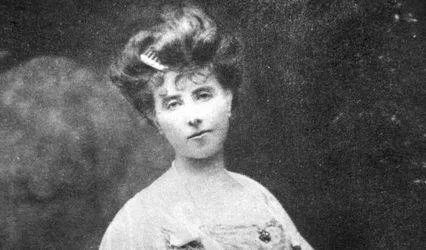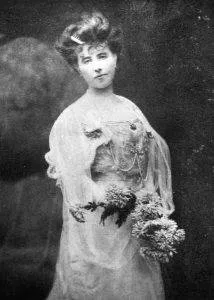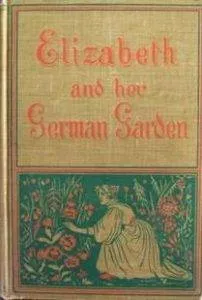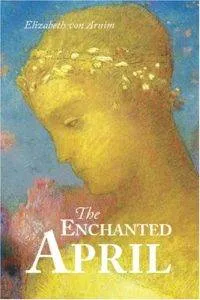
Reading Pathways: Elizabeth von Arnim
This content contains affiliate links. When you buy through these links, we may earn an affiliate commission.
 I have fallen in love for the first time in a long time, with a woman who’s been dead since 1941. Elizabeth von Arnim was born simple Mary Annette Beauchamp in Australia in 1866 to a large family (which included her New Zealander cousin, Katherine Mansfield), and raised in England from her early childhood. She married a German count in the early 1890s and proceeded to have five children and settle herself deeply in at his country estate in Pomerania for nearly twenty years (though she was by no means without company- her children were taught by the likes of E.M. Forster and Hugh Walpole). She took up writing during her marriage in part to save her husband from his massive debts (which she didn’t do too badly at, as you’ll see below), and really never stopped writing after that. After he died, she set herself up as a literary and society hostess in Switzerland and had an affair with HG Wells, had a second, disastrous marriage with a second aristocrat (Earl Russell, brother of Bertrand), traveled extensively, and finally died shortly after fleeing to the United States at the outbreak of WWII in 1939. Her rather fascinating life, as you might imagine, provided plenty of fodder for the over twenty novels she wrote in her lifetime. Her witty, highly observant, but feeling personality provided the rest.
It is this last that has drawn me to her and held me there and is likely to make me read as much of her catalog as I can get my hands on this year. Her voice is irresistible and immediately recognizable once you’ve read enough of her, but never quite exactly the same so as to get tiresome. She can wrap you up with a warm blanket and the sun on your face, walk you through biting, Thackeray-like visions of her local Vanity Fair, surprise a laugh out of you and make you ache with barely understood sadness all in the same book. If you’ve never read von Arnim, I envy you for being introduced to her voice for the first time, and if I had to narrow it down and give you three places to start, here’s what I’d suggest:
I have fallen in love for the first time in a long time, with a woman who’s been dead since 1941. Elizabeth von Arnim was born simple Mary Annette Beauchamp in Australia in 1866 to a large family (which included her New Zealander cousin, Katherine Mansfield), and raised in England from her early childhood. She married a German count in the early 1890s and proceeded to have five children and settle herself deeply in at his country estate in Pomerania for nearly twenty years (though she was by no means without company- her children were taught by the likes of E.M. Forster and Hugh Walpole). She took up writing during her marriage in part to save her husband from his massive debts (which she didn’t do too badly at, as you’ll see below), and really never stopped writing after that. After he died, she set herself up as a literary and society hostess in Switzerland and had an affair with HG Wells, had a second, disastrous marriage with a second aristocrat (Earl Russell, brother of Bertrand), traveled extensively, and finally died shortly after fleeing to the United States at the outbreak of WWII in 1939. Her rather fascinating life, as you might imagine, provided plenty of fodder for the over twenty novels she wrote in her lifetime. Her witty, highly observant, but feeling personality provided the rest.
It is this last that has drawn me to her and held me there and is likely to make me read as much of her catalog as I can get my hands on this year. Her voice is irresistible and immediately recognizable once you’ve read enough of her, but never quite exactly the same so as to get tiresome. She can wrap you up with a warm blanket and the sun on your face, walk you through biting, Thackeray-like visions of her local Vanity Fair, surprise a laugh out of you and make you ache with barely understood sadness all in the same book. If you’ve never read von Arnim, I envy you for being introduced to her voice for the first time, and if I had to narrow it down and give you three places to start, here’s what I’d suggest:
 Elizabeth and Her German Garden
This was the book that made von Arnim famous. It was published in 1898 and had to be reprinted twenty times within the first year (I happened upon a copy from the seventh reprinting at a book sale this year and serendipity doesn’t begin to cover what I feel about that treasure). The book is semi-autobiographical and centers on a German wife and mother who becomes obsessed with gardening and her struggles to create the perfect garden around her house- like a true lover of her craft, she becomes fixated on achieving her dream to the exclusion of all else when possible, including her house and family. Why was it so popular? Like I’m telling you guys: her voice. The way she narrates her every day frustrations with learning about her garden with humor and self-deprecation, the way she pauses to deal with her children (charmingly called the April baby, May baby and June baby, respectively) and nearly always feels herself out of her depth. The way she teases the “Man of Wrath,” her husband, and negotiates around his moods while maintaining an admirable spirit in spite of conventions and without alienating readers of the era (her cleverest trick is simply recording verbatim the pompous and ridiculous things he says about women and life and then moving on- or putting her mocking words into the mouth of her witty friend). Her desire to just be left alone and retire from the world with her book and her flowers, but her irresistible insights into how the world works when she is forced to deal with it.
The book is set up as a series of diary entries and she writes with such a natural flow of thought that she can cover an entire day’s thoughts and you’ll think it’s still the middle of the morning. She became known as “Elizabeth” because of this book and wrote a series of sequels detailing “Elizabeth’s” continuing adventures (my favorite of which so far is The Solitary Summer, by the way- chock full of bibliophilia and gleefully anti-social behavior- it’s lovely). It’s hard to resist Elizabeth and her garden- I suggest you don’t try.
Elizabeth and Her German Garden
This was the book that made von Arnim famous. It was published in 1898 and had to be reprinted twenty times within the first year (I happened upon a copy from the seventh reprinting at a book sale this year and serendipity doesn’t begin to cover what I feel about that treasure). The book is semi-autobiographical and centers on a German wife and mother who becomes obsessed with gardening and her struggles to create the perfect garden around her house- like a true lover of her craft, she becomes fixated on achieving her dream to the exclusion of all else when possible, including her house and family. Why was it so popular? Like I’m telling you guys: her voice. The way she narrates her every day frustrations with learning about her garden with humor and self-deprecation, the way she pauses to deal with her children (charmingly called the April baby, May baby and June baby, respectively) and nearly always feels herself out of her depth. The way she teases the “Man of Wrath,” her husband, and negotiates around his moods while maintaining an admirable spirit in spite of conventions and without alienating readers of the era (her cleverest trick is simply recording verbatim the pompous and ridiculous things he says about women and life and then moving on- or putting her mocking words into the mouth of her witty friend). Her desire to just be left alone and retire from the world with her book and her flowers, but her irresistible insights into how the world works when she is forced to deal with it.
The book is set up as a series of diary entries and she writes with such a natural flow of thought that she can cover an entire day’s thoughts and you’ll think it’s still the middle of the morning. She became known as “Elizabeth” because of this book and wrote a series of sequels detailing “Elizabeth’s” continuing adventures (my favorite of which so far is The Solitary Summer, by the way- chock full of bibliophilia and gleefully anti-social behavior- it’s lovely). It’s hard to resist Elizabeth and her garden- I suggest you don’t try.
 The Enchanted April
This is by far the best known of her works. It’s been made into a charming movie, it’s been kept alive in book clubs, it’s the lightest, the airiest, the most full of sun and relaxation and with the most chances for a relatable storyline. It centers on four women, either barely acquaintances or total strangers, who band together to rent a manor house in Italy for the month of April. While nearly completely different people and personalities, all four women are struggling with something similar- something to do with the weight of life, and specifically with the men providing that weight and how long they’ve been carrying it. Their holiday of sun, idleness and space from their everyday lives provides each woman with a different answer, but in any case revives them to face the world again. It’s an optimistic book that many people can relate to and understand and it isn’t surprising that it is the most popular of her books.
I recommend that you read it second only because after you’ve met Elizabeth, as charming as she is, perhaps you’ll understand even better why these women desperately need to do what they do. von Arnim is careful, in all her books, to keep the humor alive and it’s clearer to me after reading both of these books why- the darker motivations that her characters even tactily admit to having are heaviness enough.
The Enchanted April
This is by far the best known of her works. It’s been made into a charming movie, it’s been kept alive in book clubs, it’s the lightest, the airiest, the most full of sun and relaxation and with the most chances for a relatable storyline. It centers on four women, either barely acquaintances or total strangers, who band together to rent a manor house in Italy for the month of April. While nearly completely different people and personalities, all four women are struggling with something similar- something to do with the weight of life, and specifically with the men providing that weight and how long they’ve been carrying it. Their holiday of sun, idleness and space from their everyday lives provides each woman with a different answer, but in any case revives them to face the world again. It’s an optimistic book that many people can relate to and understand and it isn’t surprising that it is the most popular of her books.
I recommend that you read it second only because after you’ve met Elizabeth, as charming as she is, perhaps you’ll understand even better why these women desperately need to do what they do. von Arnim is careful, in all her books, to keep the humor alive and it’s clearer to me after reading both of these books why- the darker motivations that her characters even tactily admit to having are heaviness enough.
 The Pastor’s Wife
This book is a whole different beast. It’s still set in Germany, still in the deep backcountry, just like Elizabeth and Her German Garden. It’s still about an English woman buried there by her marriage- in this case to a German pastor obsessed less by bringing people to God than improving the terrible soil of East Pomerania, experimenting with new scientific methods day and night, and tending to his flock once every two weeks. Ingeborg meets the pastor the first time she’s ever been independently away from her family while taking a spur-of-the-moment tour to Switzerland, and finds herself betrothed without quite knowing how, or quite being sure she wanted to be to begin with. The rest of the book details her struggle to become the perfect pastor’s wife against both clearly placed and invisible odds. It made me so angry I couldn’t see straight by the end- probably one of the most effective, perhaps-not-intentionally-so feminist tracts I’ve read. Von Arnim effectively traces the hopelessness of this girl’s situation, this girl who wants to do good and be good and be loved and do the right thing and be happy and is more than willing to give her life to do so by the traditional means available to her, even by deceiving herself into turning her desert of a home into a paradise- and how despite her intelligence, her attractiveness, her observational abilities, her eagerness to please- she never had a chance. And when she’s given one, it’s sure to be crushed underfoot by someone who thinks he (of course he) knows what’s best for her and is doing her the great favor of putting his boot on her face while mansplaining all about it. This apparently mild book about a bishop’s daughter trying to be a good girl packs a slowly gathering, but powerful punch. If, by this point, you were ready to dismiss von Arnim as a lovely, but slight, purveyor of distracting tales about gardens and castles- this book should fix that right quick.
I’ve got one more piece of good news for you, before you head out to grab her books. Bless the book gods and copyright law for our luck-many of her books are now in the public domain and can be found online at Project Gutenberg- so I hope you can head out there all the faster and rediscover this once much-loved and now rather undeservingly forgotten writer who deserves a renaissance yesterday. Let’s band together and give it to her, shall we?
The Pastor’s Wife
This book is a whole different beast. It’s still set in Germany, still in the deep backcountry, just like Elizabeth and Her German Garden. It’s still about an English woman buried there by her marriage- in this case to a German pastor obsessed less by bringing people to God than improving the terrible soil of East Pomerania, experimenting with new scientific methods day and night, and tending to his flock once every two weeks. Ingeborg meets the pastor the first time she’s ever been independently away from her family while taking a spur-of-the-moment tour to Switzerland, and finds herself betrothed without quite knowing how, or quite being sure she wanted to be to begin with. The rest of the book details her struggle to become the perfect pastor’s wife against both clearly placed and invisible odds. It made me so angry I couldn’t see straight by the end- probably one of the most effective, perhaps-not-intentionally-so feminist tracts I’ve read. Von Arnim effectively traces the hopelessness of this girl’s situation, this girl who wants to do good and be good and be loved and do the right thing and be happy and is more than willing to give her life to do so by the traditional means available to her, even by deceiving herself into turning her desert of a home into a paradise- and how despite her intelligence, her attractiveness, her observational abilities, her eagerness to please- she never had a chance. And when she’s given one, it’s sure to be crushed underfoot by someone who thinks he (of course he) knows what’s best for her and is doing her the great favor of putting his boot on her face while mansplaining all about it. This apparently mild book about a bishop’s daughter trying to be a good girl packs a slowly gathering, but powerful punch. If, by this point, you were ready to dismiss von Arnim as a lovely, but slight, purveyor of distracting tales about gardens and castles- this book should fix that right quick.
I’ve got one more piece of good news for you, before you head out to grab her books. Bless the book gods and copyright law for our luck-many of her books are now in the public domain and can be found online at Project Gutenberg- so I hope you can head out there all the faster and rediscover this once much-loved and now rather undeservingly forgotten writer who deserves a renaissance yesterday. Let’s band together and give it to her, shall we?










